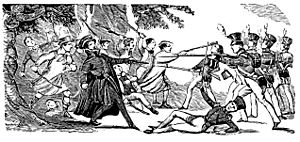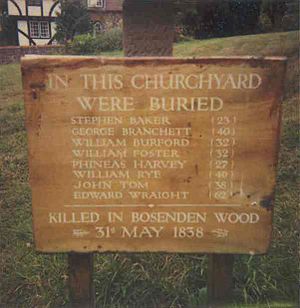Battle of Bossenden Wood facts for kids
The Battle of Bossenden Wood happened on May 31, 1838. It took place near Hernhill in Kent, England. Some people call it the last battle fought on English soil.
This short fight was between a small group of farm workers and some soldiers. The soldiers came from Canterbury to arrest the workers' leader. This leader called himself Sir William Courtenay. But his real name was John Nichols Tom. He was from Truro and had spent time in a mental hospital.
Eleven people died in the battle. This included Courtenay, eight of his followers, and two soldiers. The battle happened because of new laws about helping poor people. It was also linked to other protests by workers at that time.
Who Was Sir William Courtenay?
John Nichols Thom arrived in Canterbury in 1832. He tried to become a politician but didn't win. Even though people thought he might be faking his identity, he became very popular.
In 1833, he was found guilty of lying in court. He had spoken up for some smugglers. At first, he was supposed to be sent away from England. But then, a woman from Cornwall said he was her missing husband. She also said he had been treated for mental illness before. So, he was sent to a mental hospital instead.
He was released in October 1837. Instead of going back to his family, he stayed in Kent. He gathered many followers in areas like Boughton under Blean and Hernhill. Farm workers and small landowners were struggling. They were unhappy with the new Poor Law of 1834. Courtenay promised them a better life. His ideas made many people want to follow him.
On May 29, Courtenay and his followers started marching. They carried a flag and a loaf of bread on a pole. This was a common symbol of protest. Courtenay rode a grey horse, and his followers walked. At first, they were peaceful. But some wealthy landowners became worried.
On May 31, 1838, a local judge, Dr. Poore, decided to arrest Tom. It's not fully clear why. A local police officer, John Mears, went to find Courtenay. He brought his brother, Nicholas Mears, and an assistant. They found Courtenay and his group at Bossenden Farm. Courtenay then shot and killed Nicholas Mears.
The Short Battle
When the judges heard about the killing, they called for soldiers. A group of soldiers from the 45th Foot regiment was sent from Canterbury. Major Armstrong led them. There were three junior officers and about one hundred soldiers. This regiment had just returned from India.
While waiting for the soldiers, some armed wealthy people and farmers shot at Courtenay's group. Courtenay and his followers were moving around the Hernhill area. By this time, some of Courtenay’s followers had run away. About 35 or 40 people were left. Most only had sticks. Courtenay had pistols and a sword. One follower also had a pistol.
The soldiers split into two groups to surround Courtenay's group. One group was led by Captain Reid. Lieutenant Henry Boswell Bennett led a smaller part of this group. This smaller group found Courtenay's band in a clearing. The other group, led by Major Armstrong, circled around to the other side.
The fight was very short, lasting only a few minutes. Courtenay shot Lieutenant Bennett, killing him. Then, Courtenay himself was shot and killed. This happened as Armstrong’s soldiers fired and charged with bayonets. Eight of Courtenay’s followers were killed or badly wounded. A young man named George Catt, who was helping the judges, was also accidentally killed by the soldiers' fire.
What Happened Next?
On June 2, Lieutenant Bennett was buried with military honors. His burial was in Canterbury Cathedral. On the same day, an investigation was held. It was decided that the deaths of Courtenay and his followers were "justifiable homicide." This means the killings were considered necessary and lawful.
The followers who died were: Stephen Baker (22), William Foster (33), William Rye (46), Edward Wraight (62), Phineas Harvey (27), William Burford (33), George Griggs (23), and George Branchett (49). Griggs and Branchett were buried in Boughton churchyard. Everyone else, including Courtenay, was buried in Hernhill churchyard.
In the days that followed, about thirty of Courtenay’s followers were arrested. Sixteen of them faced serious accusations related to the deaths. Ten men eventually went to trial in August. The others were released.
Thomas Mears and William Price were tried first. The jury found them responsible but asked for mercy. The judge, Lord Denman, said they would be put to death. But he immediately told them the sentence would not happen.
Seeing this, the nine others who faced accusations related to Lieutenant Bennett's death admitted their involvement. They also received the death sentence, but it was immediately changed. Thomas Mears and William Wills were sent to Australia for life. William Price was sent for ten years. The rest were sent to prison for one year.




